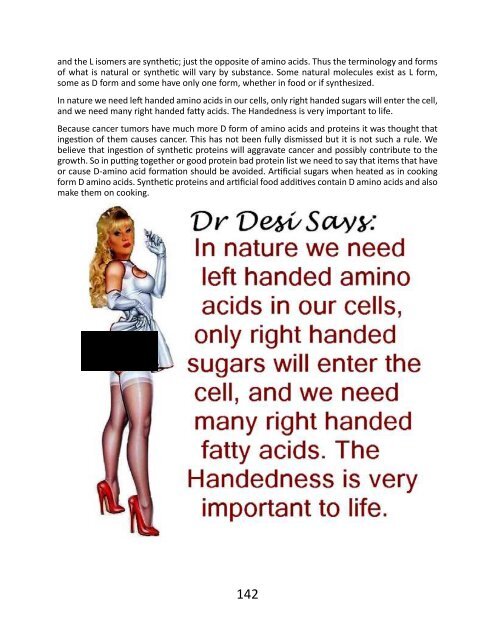Create successful ePaper yourself
Turn your PDF publications into a flip-book with our unique Google optimized e-Paper software.
and the L isomers are synthetic; just the opposite of amino acids. Thus the terminology and forms<br />
of what is natural or synthetic will vary by substance. Some natural molecules exist as L form,<br />
some as D form and some have only one form, whether in food or if synthesized.<br />
In nature we need left handed amino acids in our cells, only right handed sugars will enter the cell,<br />
and we need many right handed fatty acids. The Handedness is very important to life.<br />
Because cancer tumors have much more D form of amino acids and proteins it was thought that<br />
ingestion of them causes cancer. This has not been fully dismissed but it is not such a rule. We<br />
believe that ingestion of synthetic proteins will aggravate cancer and possibly contribute to the<br />
growth. So in putting together or good protein bad protein list we need to say that items that have<br />
or cause D-amino acid formation should be avoided. Artificial sugars when heated as in cooking<br />
form D amino acids. Synthetic proteins and artificial food additives contain D amino acids and also<br />
make them on cooking.<br />
D-form amino acids tend to taste sweet, whereas L-forms are usually tasteless. Spearmint leaves<br />
and caraway seeds, respectively, contain L-carvone and D-carvone - enantiomers of carvone. These<br />
smell different to most people because our olfactory receptors also contain chiral molecules that<br />
behave differently in the presence of different enantiomers. Thus the artificial sweeteners with<br />
the Dextro (poisonous) amino acids are to be avoided and specifically not used in cooking.<br />
L-amino acids and plant stimulation<br />
THE EFFECT OF ENZYMATICALLY EXTRACTED L AMINO ACIDS ON PLANTS<br />
Amino acids – the components in protein – are the building blocks of all cell formation. Amino<br />
acids are necessary components in many processes in the plant, among them the photosynthesis<br />
which produces carbohydrates necessary for plant growth. All plants are capable of synthesizing<br />
amino acids, but it is a complex and energy demanding process that requires carbon and oxygen,<br />
hydrogen and nitrogen. The application of amino acids allows therefore for energy saving and<br />
better plant development during the critical stages of a plant’s cycle when it requires highly<br />
available elements.<br />
Amino acids:<br />
Amino acids are organic substances formed by an asymmetrical carbon atom that is joined to:<br />
• An Amine group –NH2<br />
• A Carboxylic group –COOH<br />
• Two radicals –R and R´ characteristic of each amino acid.<br />
Theoretically, the number of possible amino acids in nature is infinite. However, for plant nutrition<br />
purposes, the relevant amino acids are L-Alfa types in which the R generic radical is substituted<br />
by a Hydrogen one.<br />
Plants, like any other organism, need certain components to promote their growth, as well as soil,<br />
sun, rain and air. The basic components of living cells are proteins, with their basic units, amino<br />
acids. Proteins are formed by amino acid sequences. Plants synthesize amino acids from primary<br />
elements: Carbon and oxygen obtained from the air, hydrogen from water. This helps to form<br />
carbohydrates through photosynthesis, and combined with the nitrogen obtained by the plants<br />
through the soil, it conducts the synthesis of amino acids through metabolic routes.<br />
L and D amino acids<br />
Stereochemistry is important in living organisms because its properties can change depending on<br />
the spacial distribution of its atomic components. All amino acids, with the exception of glycine<br />
(which doesn’t have asymmetric carbon), can be found in forms L and D, in function of the spacial<br />
disposition of the groups that join asymmetric carbon. This disposition diverts polarized light in<br />
one way or another. This optical characteristic is what divides amino acids into L or D.<br />
Only L-Alfa amino acids form part of the proteins utilized by plants and promote changes in plant<br />
metabolic activity.<br />
142 143

















